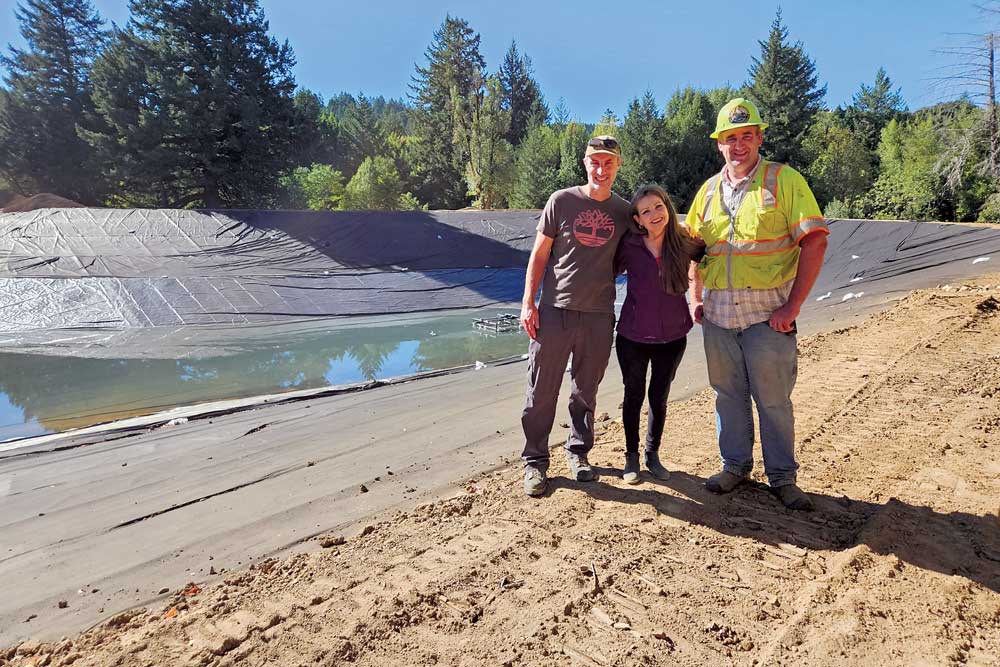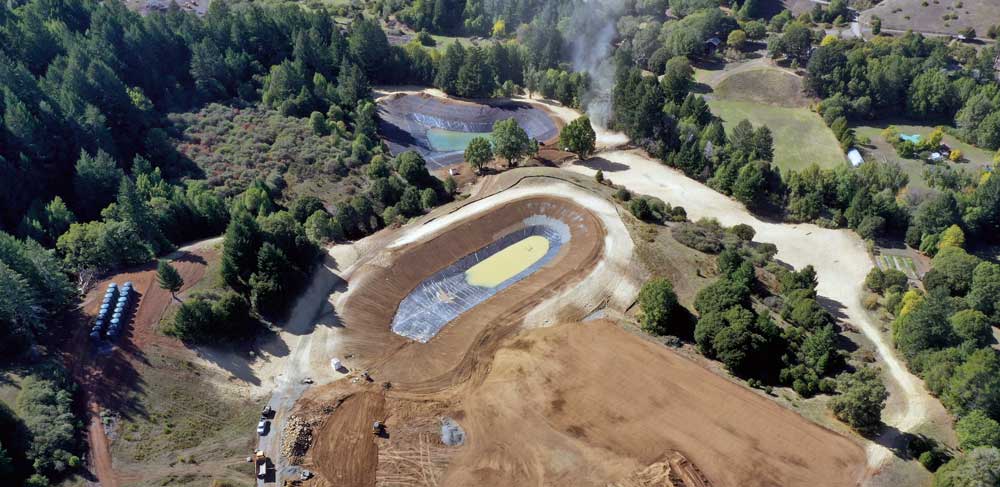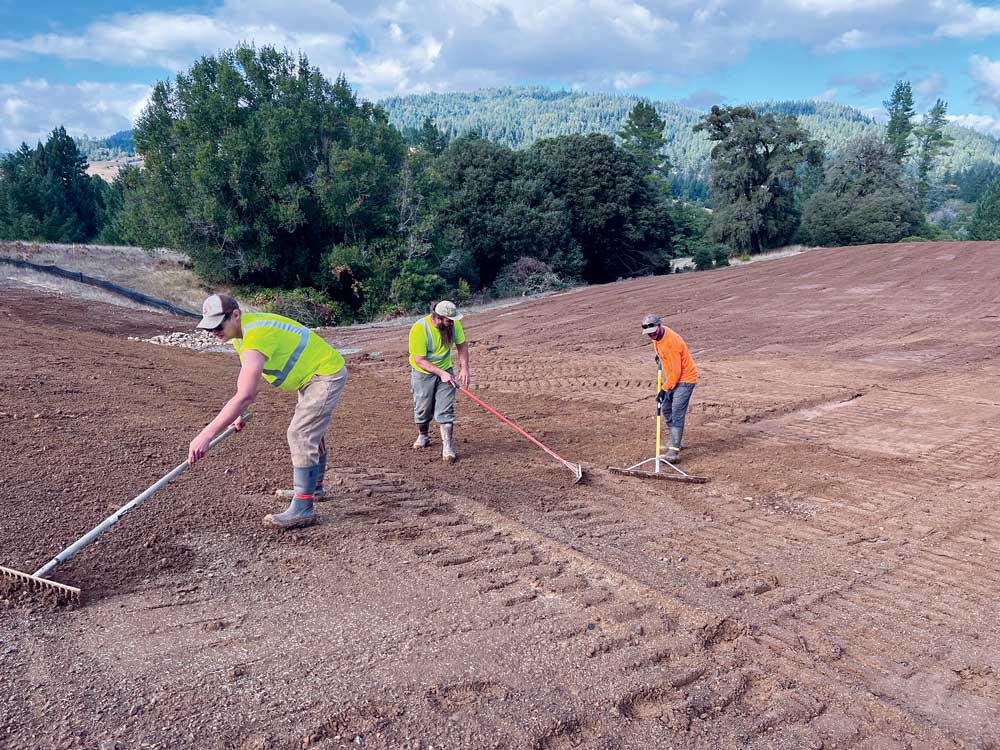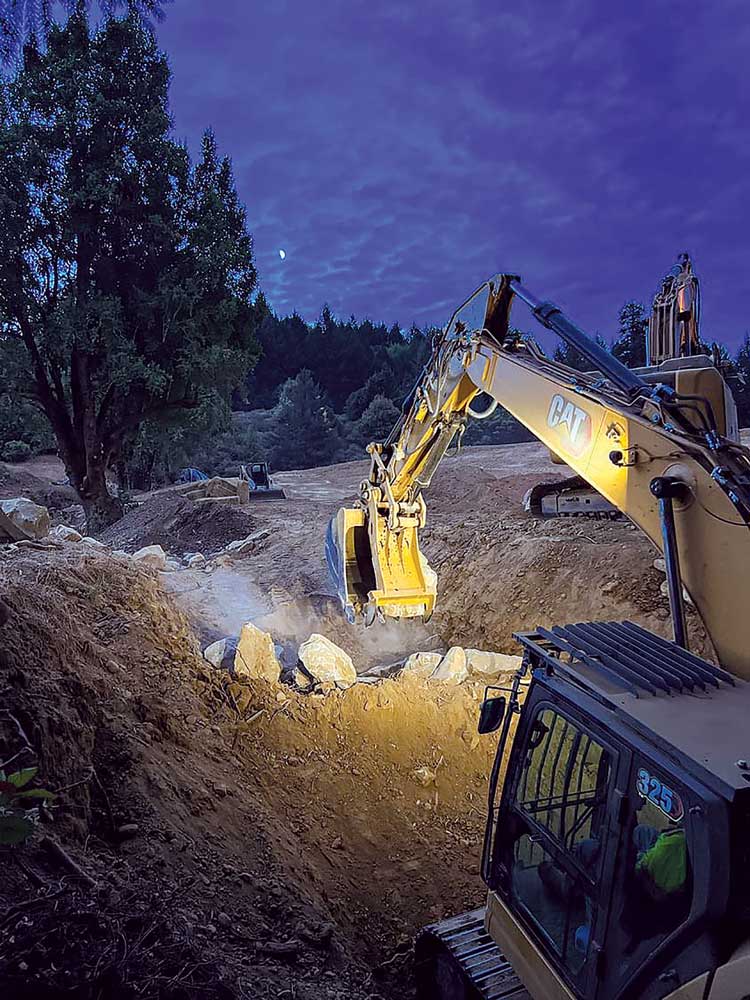If You Build It, Will Coho Run? Marshall Ranch Ponds Constructed to Maintain Redwood Creek Summer Flows

By Dana Stolzman, Executive Director, Salmonid Restoration Federation
The Build Up
Coho salmon persist in scattered watersheds throughout the North Coast of California, especially in forested tributaries that provide habitat refugia. Redwood Creek is a rare example of a human-populated watershed that still retains intrinsic potential for coho salmon recovery. For over 10 years, the Salmonid Restoration Foundation (SRF) has studied low-flow trends in Redwood Creek and worked proactively in the community to collaborate and communicate about flow-enhancement opportunities.
Community Building is Not a Destination, it is an Interactive Process. Community Building does not often proceed in a linear fashion but rather takes a meandering scenic route with twists and turns you may not anticipate but that often lead to a more integrated understanding of community concerns, communication best practices, and opportunities for collaboration.
Talking about water usage in a time of extended drought and economic collapse of the local cannabis industry is inherently a hot topic. Initially in our early years of monitoring, there was a lot of finger-pointing about water scarcity, whether it was attributed to the legacy impacts of logging, unregulated diversions, or longer dry seasons associated with climate change.
Within a few years of outreach and monitoring, we noticed that landowners cared less about assigning blame and more about sustainable water management options because it was clear that drying trends and fire risk were not going away. Landowners and restorationists quickly adapted to the changing landscape, and SRF with Stillwater Sciences as the technical lead continued working on feasibility studies of Redwood Creek to understand the most viable options for maintaining instream flows for coho salmon and improving water security for landowners.
Our project team (Stillwater Sciences, SRF, with a technical advisory team) recognized that the single greatest project opportunity was on the historic Marshall Ranch, the largest ownership in Redwood Creek. Our original design was for one 15-million-gallon pond that could release 50 gallons per minute (gpm) during the five-month dry season to fulfill target flows for Redwood Creek to ensure hydrologic connectivity. Although this was widely recognized as a laudable goal, feedback from concerned neighbors and community members encouraged our project team to downsize the proposed project to 10-million gallons and identify flow-enhancement opportunities in Upper Redwood Creek.

Photos by Hugh McGee, Native Ecosystems

Our team went back to the drawing board and spent another year designing and resubmitting CEQA documents. The new design was for two ponds (one on the upper terrace and one on the lower terrace) totaling 10 million gallons of water storage that could deliver 30gpm continuously or be managed adaptively to release varying flows to mimic natural hydrologic fluctuations. This recently implemented design was fully supported by the community and passed the Planning Commission unanimously.
The process to this point involved years of community outreach, collaborating with various stakeholders, and ongoing communication with the Wildlife Conservation Board Streamflow Enhancement Program, the primary project funder, and the various permitting agencies.
In the end, it was immeasurably worthwhile to create an innovative restoration project that incorporated input from the community and that is expected to improve conditions in Redwood Creek for decades to come.
The Build Out
The Marshall Ranch is the largest contiguous private holding in Redwood Creek, a critical salmon-bearing tributary that flows into the South Fork Eel River.
The Ranch is fully protected under a conservation easement, and bridges Redwood Creek, Somerville Creek, and Sproul Creek. This working ranch has been in the Marshall family ownership since the 1800s and is protected in perpetuity with conservation “envelopes” for restoration opportunities such as a flow-enhancement project that includes the 10 million gallons of winter water storage between two off-channel ponds and over 100,000 gallons stored in water tanks that will be plumbed for fire-fighting emergencies. The purpose of this project is to release cool water into Redwood Creek during the five-month dry season to benefit threatened salmonids and other aquatic species. The flow releases will benefit the mainstem of the creek from the Marshall Ranch all the way to the confluence with the South Fork Eel River.
The ponds were constructed in the summer of 2023 on two terraces adjacent to Redwood Creek on the Marshall Ranch. Stillwater Sciences and Edwards Excavation led a team of sub-contractors in the myriad construction phases including grading, excavating and lining the ponds; large wood installation to enhance fish habitat in Redwood Creek, rock grade control structures to stabilize incised gullies; installing a French drain and an infiltration gallery, as well as all the associated plumbing to allow for metered and adaptively managed flow releases. The project site was then seeded with native grasses for erosion control and light grazing (a designated use under the Conservation Easement). Greenwired is building the solar array and grid inter-tie system that will power the pumps, valves, meters and gages needed for the long-term operations and maintenance of the project.
In conjunction with the implementation project on the Marshall Ranch, SRF is developing a Storage and Forbearance Program downstream of the Marshall Ranch to ensure that the cool summertime flow releases remain instream and are not diverted by downstream water users. SRF and Stillwater Sciences have conducted site assessments on mainstem Redwood Creek, and we are pleased with how many landowners are interested in participating in the program.
Additionally, SRF is pursuing a flow-enhancement project on the Lost Coast Forestland property near the headwaters of Redwood Creek. The Marshall Ranch and Lost Coast Forestland flow-enhancement projects combined would help accomplish our target flow goal of an average of 50 gallons per minute of flow release, providing flow connectivity that sustains fish during the dry season.

Photo by Joaquin Courtemanche
In Summary
After years of outreach, monitoring, and a Redwood Creek feasibility analysis, SRF and Stillwater Sciences have successfully developed and are pursuing a variety of flow-enhancement opportunities ranging from groundwater recharge in the headwaters of Redwood Creek to flow-release projects in the mainstem on the Marshall Ranch, storage and forbearance projects downstream, and a recently funded forest-thinning component that will study the nexus between selective forest thinning and dry season streamflow.
This project was developed by several restoration partners, including Stillwater Sciences, the lead technical consultants; the Marshall Ranch General Manager David Sanchez, and the Marshall Ranch family representative Elizabeth Marshall Maybee, who had the vision to preserve the ranch through conservation easements; and Hicks Law, who oversaw the Appropriative Water Right and provides expert legal guidance to the project team. SRF’s Executive Director Dana Stolzman stated, “SRF is the project proponent, but this project could not have evolved without the ongoing support of the Wildlife Conservation Board, State Coastal Conservancy, and the hard work of the project team. In this era of extended drought conditions, climate change, and intensified fire risk, innovative projects like the Marshall Ranch Flow Enhancement are needed to improve instream flows.”
This evolving work proves the adage that it takes a community to raise a coho!
For more information: calsalmon.org
